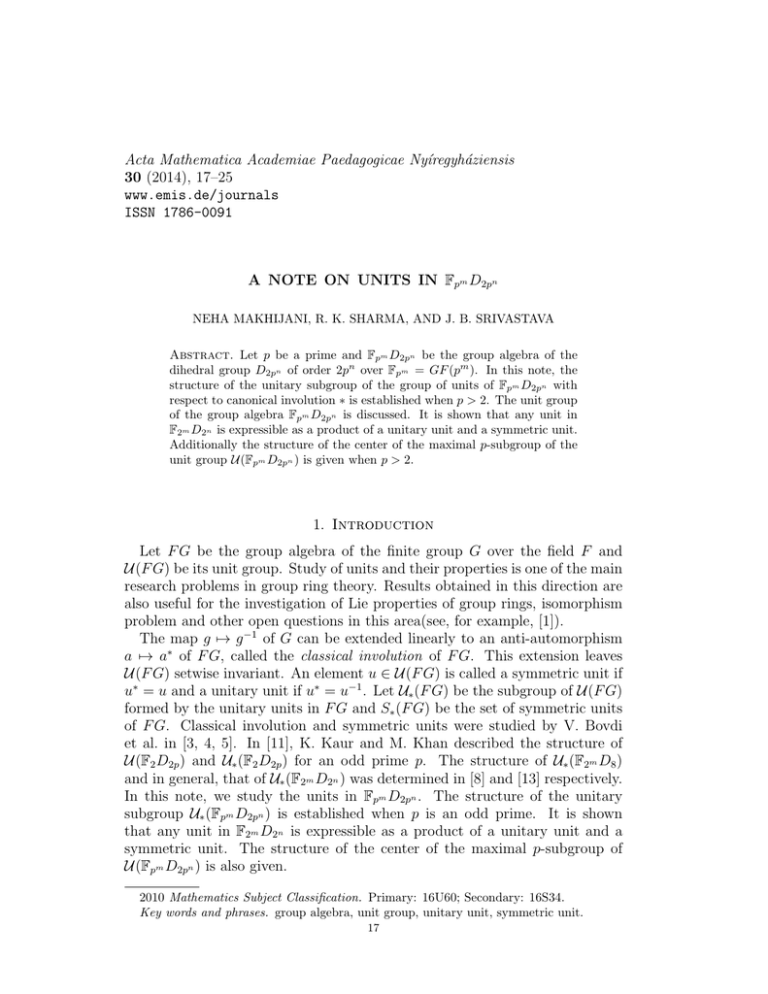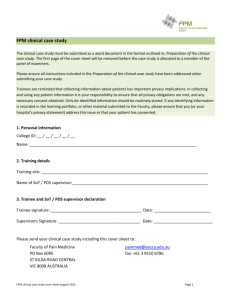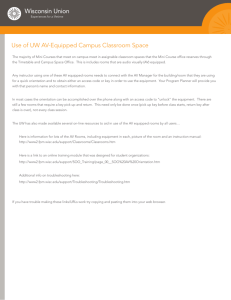Acta Mathematica Academiae Paedagogicae Ny´ıregyh´ aziensis 30 (2014), 17–25 www.emis.de/journals
advertisement

Acta Mathematica Academiae Paedagogicae Nyı́regyháziensis
30 (2014), 17–25
www.emis.de/journals
ISSN 1786-0091
A NOTE ON UNITS IN Fpm D2pn
NEHA MAKHIJANI, R. K. SHARMA, AND J. B. SRIVASTAVA
Abstract. Let p be a prime and Fpm D2pn be the group algebra of the
dihedral group D2pn of order 2pn over Fpm = GF (pm ). In this note, the
structure of the unitary subgroup of the group of units of Fpm D2pn with
respect to canonical involution ∗ is established when p > 2. The unit group
of the group algebra Fpm D2pn is discussed. It is shown that any unit in
F2m D2n is expressible as a product of a unitary unit and a symmetric unit.
Additionally the structure of the center of the maximal p-subgroup of the
unit group U(Fpm D2pn ) is given when p > 2.
1. Introduction
Let F G be the group algebra of the finite group G over the field F and
U(F G) be its unit group. Study of units and their properties is one of the main
research problems in group ring theory. Results obtained in this direction are
also useful for the investigation of Lie properties of group rings, isomorphism
problem and other open questions in this area(see, for example, [1]).
The map g 7→ g −1 of G can be extended linearly to an anti-automorphism
a 7→ a∗ of F G, called the classical involution of F G. This extension leaves
U(F G) setwise invariant. An element u ∈ U(F G) is called a symmetric unit if
u∗ = u and a unitary unit if u∗ = u−1 . Let U∗ (F G) be the subgroup of U(F G)
formed by the unitary units in F G and S∗ (F G) be the set of symmetric units
of F G. Classical involution and symmetric units were studied by V. Bovdi
et al. in [3, 4, 5]. In [11], K. Kaur and M. Khan described the structure of
U(F2 D2p ) and U∗ (F2 D2p ) for an odd prime p. The structure of U∗ (F2m D8 )
and in general, that of U∗ (F2m D2n ) was determined in [8] and [13] respectively.
In this note, we study the units in Fpm D2pn . The structure of the unitary
subgroup U∗ (Fpm D2pn ) is established when p is an odd prime. It is shown
that any unit in F2m D2n is expressible as a product of a unitary unit and a
symmetric unit. The structure of the center of the maximal p-subgroup of
U(Fpm D2pn ) is also given.
2010 Mathematics Subject Classification. Primary: 16U60; Secondary: 16S34.
Key words and phrases. group algebra, unit group, unitary unit, symmetric unit.
17
18
NEHA MAKHIJANI, R. K. SHARMA, AND J. B. SRIVASTAVA
The following presentation of D2pn shall be used:
n
h a, b | ap , b2 , b−1 ab = a−1 i
2. Preliminaries
For a normal subgroup N of G, the natural homomorphism
G → G/N, g 7→ gN
can be extended to an F -algebra homomorphism
εN : F G → F (G/N )
defined by
X
ag g 7→
g∈G
X
ag gN , ag ∈ F . The kernel of εN , denoted by
g∈G
∆(G, N ), is the ideal of F G generated by {x − 1 | x ∈ N } in F G and
F G/∆(G, N ) ∼
= F (G/N ). It can be seen that ∆(G, N ) = ∆(N ) F G =
F G ∆(N ), where ∆(N ) = ∆(N, N ).
Let J(F G) denote the Jacobson radical of the group algebra F G. From [12,
Chap. 8, Lem. 1.17], it follows that if G is a locally finite p-group and F is a
field of characteristic p > 0, then J(F G) = ∆(G). Hence
U(F G) = (1 + J(F G)) × F ∗ .
That is, U(F G) = { x ∈ F G | εG (x) 6= 0 }.
The following is a more general result.
Lemma 2.1. Let k be a perfect field and G be a finite group. Then
kG
∼
U(kG) = (1 + J(kG)) o U
.
J(kG)
Proof. Observe that
1 + J(kG)
1
inc
U(kG)
ψ
U
kG
J(kG)
1
is a short exact sequence of groups, where ψ(x) = x + J(kG) ∀ x ∈ U(kG).
By Wedderburn-Malcev theorem [6, Thm. 6.2.1], it follows that there exists
a semisimple subalgebra B of kG such that
kG = B ⊕ J(kG)
kG
and thus for each x + J(kG) ∈
, there exists a unique xB ∈ B such that
J(kG)
x + J(kG) = xB + J(kG).
Define φ : U
kG
J(kG)
→ U(kG) as
φ (x + J(kG)) = xB ,
x + J(kG) ∈ U
kG
J(kG)
.
A NOTE ON UNITS IN Fpm D2pn
Then φ is a group homomorphism such that ψ o φ = id |
hence
kG
∼
U(kG) = (1 + J(kG)) o U
.
J(kG)
19
U (kG/J(kG))
and
3. The unitary subgroup U∗ (Fpm D2pn )
The unitary subgroup U∗ (F2m D2n ) was discussed in [13]. As a consequence
of the following theorem, we shall obtain the structure of U∗ (Fpm D2pn ) when
p > 2.
Theorem 3.1. Let F be a field of characteristic p > 2, G be a finite group
having an abelian p-subgroup A of index 2 and an element b that inverts every
element of A. Then
U∗ (F G) = U∗ (F A) o hbi.
Proof. Observe that z = b2 ∈ A. Thus z b = z −1 which implies z = z −1 and
hence b4 = 1. But since |G| = 2|A|, we find that o(b) = 2.
If X ∈ U∗ (F G), then X = Y + Zb for some Y, Z ∈ F A such that εG (Y ) 6= 0
or εG (Z) 6= 0.
If εG (Y ) 6= 0, then Y ∈ U (F A) and hence it is possible to write
X = Y (1 + W b)
where W = Y −1 Z =
X
αa a ∈ F A.
a∈A
Now XX ∗ = 1. This implies
Y (1 + W b) (Y (1 + W b))∗ = 1,
⇒ Y (1 + W b)(1 + W b)∗ Y ∗ = 1,
⇒ Y ∗ Y 1 + 2W b + (W b)2 = 1,
⇒ Y ∗ Y = 1 and W = 0,
⇒ X = Y ∈ U∗ (F A) .
However if εG (Y ) = 0, then εG (Z) 6= 0. Since Xb = Z + Y b ∈ U∗ (F G),
therefore via similar arguments as above, we find Xb = Z ∈ U∗ (F A).
Also b−1 Cb = C ∗ = C −1 ∈ U∗ (F A) for all C ∈ U∗ (F A). Thus in either
case, X ∈ U∗ (F A) o hbi and U∗ (F G) = U∗ (F A) o hbi.
Remark 1. The basis of V∗ (Fpm A) = {u ∈ U∗ (Fpm A) | εA (u) = 1} is known
from [2, Theorem 3] which simplifies the structure of U∗ (Fpm G) as
U∗ (Fpm A) = V∗ (Fpm A) × h−1i.
Corollary 3.2. Let F be a field of characteristic p > 2. Then
U∗ (F D2pn ) = U∗ (F hai) o hbi.
20
NEHA MAKHIJANI, R. K. SHARMA, AND J. B. SRIVASTAVA
Moreover, if F = Fpm , then
!
n
Y
U∗ (F D2pn ) ∼
=
Cpmi i × C2
o C2 ,
i=1
n−i−1
where mn =
(p − 1)2
∀ i, 1 ≤ i ≤ n − 1.
2
m(p − 1)
mp
and mi =
2
Proof. Using [2, Theorem 1], we find
V∗ (F C ) =
pm
pn
n
Y
Cpmi i .
i=1
4. Units in Fpm D2pn
Lemma 4.1. Let H be the subset of F2m D2n+1 consisting of the elements of
the form
1+
c
X
i
αi a + a
−i
+
i=1
c
X
βi b ai + a−i−1
i=0
where αi , βi ∈ F2m and c = 2n−1 − 1. Then H is an abelian subgroup of
1 + J(F2m D2n+1 ) and H ⊆ S∗ (F2m D2n+1 ).
Proof. It is apparent that H ⊆ 1 + J(F2m D2n+1 ).
Let
c
c
X
X
i
−i
u1 = 1 +
αi a + a
+
βi b ai + a−i−1 ,
i=1
u2 = 1 +
i=0
c
X
i=1
αi0
i
a +a
−i
+
c
X
βi0 b ai + a−i−1
i=0
be any two elements of H.
Then
c
c
X
X
0
i
−i
u1 u2 = 1 +
(αi + αi ) a + a
+
(βi + βi0 ) b ai + a−i−1
+
+
+
i=1
c
c
X X
i=1 j=1
c
c
X
X
i=1 j=0
c
c
X
X
i=0
and u1 u2 = u2 u1 .
j=0
i=0
αi αj0 ai+j + a−i−j + ai−j + a−i+j
αi βj0 + αi0 βj b ai+j + a−i−j−1 + a−i+j + ai−j−1
βi βj0 ai−j + a−i+j + ai+j+1 + a−i−j−1 ∈ H
A NOTE ON UNITS IN Fpm D2pn
21
2
n
Since [b(ai + a−i−1 )] = (a2i+1 + a−2i−1 ), it is apparent that u2 = 1 and u∗ =
u, u ∈ H.
Theorem 4.2. 1 + J(F2m D2n+1 ) = U∗ (F2m D2n+1 )H, where H is the group
defined in Lemma 4.1.
Proof. Observe that U∗ (F2m D2n+1 ) ⊆ 1 + J(F2m D2n+1 ).
Let
2n−1
2n−1
X−1
X−1
i
−i
+
βi b ai + a−i−1 ∈ U∗ (F2m D2n+1 ) ∩ H.
u=1+
αi a + a
i=0
i=1
2
As a consequence u = 1 and
2n−1
X−1
αi2
2i
a +a
−2i
+
2n−1
X−1
i=1
βi2 a2i+1 + a−2i−1 = 0,
i=0
moreover
2n−2
X−1
(αi + α2n−1 −i )2 a2i + a−2i
i=1
+
2n−2
X−1
(βi + β2n−1 −i−1 )2 a2i+1 + a−2i−1 = 0,
i=0
and
u=
2n−2
X−1
i=1
i
αi a + a
−i
+
2n−2
X−1
i
βi a + a
−i−1
!
1+a
2n−1
i=0
n−2
+ α2n−2 (a2
n−1 m
Thus | U∗ (F2m D2n+1 ) ∩ H | = 22
+ a−2
n−2
).
. Also from [5], it is known that
n−1 m
| U∗ (F2m D2n+1 ) | = 23.2
,
showing that
n−1 +(2n −1)−2n−1 )
| U∗ (F2m D2n+1 )H | = 2m(3.2
= | 1 + J(F2m D2n+1 ) |
and hence
1 + J(F2m D2n+1 ) = U∗ (F2m D2n+1 )H.
Corollary 4.3. Every unit in F2m D2n is expressible as a product of a unitary
unit and a symmetric unit.
Proof. Since U(F2m D2n ) = (1 + J(F2m D2n )) × F∗2m , the proof follows.
It follows from Lemma 2.1 that in order to study the structure of U(F G),
it is important to study its subgroup 1 + J(F G). In [14], M. Khan et al.
showed that Z(1 + J(F3m D6 )) is an elementary abelian 3-group. The result
was improved by J. Gildea in [7] and for any odd prime p, the center of maximal
22
NEHA MAKHIJANI, R. K. SHARMA, AND J. B. SRIVASTAVA
p-subgroup of U(Fpn D2p ) was described as an elementary abelian p-group using
an established isomorphism between Fpn D2p and M2p (Fpn ) [9]. In this context,
we now prove a generalized result.
Theorem 4.4. Let p be any odd prime. Then
(a) U(Fpm D2pn ) ∼
= Vm,n o F∗pm × F∗pm , where Vm,n = 1 + J(Fpm D2pn ), the
maximal p-subgroup of U(Fpm D2pn ).
(b) If n ≥ 2, then Z(Vm,n ) is a group of exponent pn and
Z(Vm,n ) ∼
=
n
Y
Cpiki
i=1
where
k1 = m
and
kt = m
pn−2 (p − 1)2
+1 ,
2
pn−t−1 (p − 1)2
2
kn = m
p−1
2
,
for all t, 1 < t < n.
n
Proof. Let G = D2pn and H = ha|ap i. Since H E G, we have
∆(G, H) = ∆(H) Fpm G = J(Fpm H) Fpm G = J(Fpm G)
by [12, Ch. 7, Theorem 2.7], as p - [G : H]. Thus
Fp m G ∼
= Fpm (G/H) ∼
= Fp m ⊕ Fp m
J (Fpm G)
and
U(Fpm G) ∼
= (1 + J(Fpm G)) o F∗pm × F∗pm .
n
Using [10, Proposition 1.9, p. 110], J(Fpm G)p = (0) and 1 + J(Fpm G) is a
p-group. This proves part (a) of the Theorem.
Now B = {bi (aj − 1) | 0 ≤ i ≤ 1, 1 ≤ j ≤ pn − 1} is a basis of J (Fpm G) =
∆(G, H). Consequently,
pn −1
X=
X
i=1
pn −1
i
αi (a − 1) +
X
βi b(ai − 1) ∈ Z(J(Fpm G)) ⇐⇒ XY = Y X
i=1
for all Y ∈ B. In particular, X ∈ Z(J(Fpn [G])), and X(a − 1) = (a − 1)X,
which implies
!
pn −1
X
β1 = βpn −1 , β2 = −
βi = βpn −2
i=1
n
and βt−1 = βt+1 , for all 1 < t < p − 1. It means
n
p −1
(β1 + β2 )
β2 = −
2
A NOTE ON UNITS IN Fpm D2pn
23
and β2 = β1 consequently
1 ≤ t ≤ pn − 1.
βt = β (say),
Therefore
X=
pn −1
pn −1
X
X
i
αi (a − 1) + βb
i=1
pn −1
!
i
(a − 1)
=
X
αi (ai − 1) + βbâ,
i=1
i=1
pn −1
where â = 1 + a + · · · + a
.
Also X ∈ Z(J(Fpn [G])) which implies
Xb(a − 1) = b(a − 1)X
⇒ αi = αpn −i ∀ i, 1 ≤ i ≤
pn − 1
2
pn −1
2
⇒X =
X
αi (ai + a−i − 2) + βbâ.
i=1
Since
n
n
p −1
p −1
2
2
X
X
αi (ai + a−i − 2) + βbâ Y = Y
αi (ai + a−i − 2) + βbâ
i=1
i=1
for all Y ∈ B, αi , β ∈ Fpn , we conclude that
n
p
−
1
i
−i
∪ {bâ}
a + a − 2 1 ≤ i ≤
2
forms a basis of Z(J(Fpm G)).
Observe that Z(Vm,n ) = 1 + Z(J(Fpm G)) and o(1 + (a + a−1 − 2)) = pn .
Thus Z(Vm,n ) is a group of exponent pn and by fundamental theorem of abelian
groups, we have
n
Y
∼
Z(Vm,n ) =
Cpiki
i=1
where ki ≥ 0.
Let X ∈ Z (J(Fpm G)). Then
p−1
X = βbâ +
n−j−1
n−1 p X−1
2 X
X
i=1 j=0
βi,j,r (ap
j (rp+i)
+ a−p
j (rp+i)
− 2).
r=0
t
For any t, 1 ≤ t ≤ n − 1, (1 + X)p = 1
t
⇒ Xp = 0
p−1
⇒
n−j−t−1 −1
n−t−1
2
X
X p X
i=1
j=0
r=0
t
p
Bi,j,r,t
(a(rp+i)p
t+j
+ a−(rp+i)p
t+j
− 2) = 0
24
NEHA MAKHIJANI, R. K. SHARMA, AND J. B. SRIVASTAVA
P t −1
where Bi,j,r,t = ps=0
βi,j,r+spn−j−t−1 .
From above we conclude that the number of elements of order ≤ pt in
Z(Vm,n ) is pmNn,t , where
n−1
X
n−t−1
p−1
p − 1 X n−j−1
t
n−j−t−1
Nn,t =
p −1
p
+
p
+1
2
2
j=0
j=n−t
(pt − 1) (pn−t − 1) (pt − 1)
+
+1
2
2
pn−t (pt − 1)
=
+1
2
=
Thus
t
X
i=1
and
iki + t
n
X
ki = mNn,t ∀t, 1 ≤ t ≤ n − 1
i=t+1
n
X
i=1
iki = m
pn + 1
2
.
The rest follows by solving the above system of equations over Fpm .
References
[1] A. A. Bovdi and J. Kurdics. Lie properties of the group algebra and the nilpotency
class of the group of units. J. Algebra, 212(1):28–64, 1999.
[2] A. A. Bovdi and A. Szakács. Unitary subgroup of the group of units of a modular group
algebra of a finite abelian p-group. Mat. Zametki, 45(6):23–29, 1989.
[3] V. Bovdi. On symmetric units in group algebras. Comm. Algebra, 29(12):5411–5422,
2001.
[4] V. Bovdi, L. G. Kovács, and S. K. Sehgal. Symmetric units in modular group algebras.
Comm. Algebra, 24(3):803–808, 1996.
[5] V. Bovdi and A. L. Rosa. On the order of the unitary subgroup of a modular group
algebra. Comm. Algebra, 28(4):1897–1905, 2000.
[6] Y. A. Drozd and V. V. Kirichenko. Finite-dimensional algebras. Springer-Verlag, Berlin,
1994.
[7] J. Gildea. The centre of the maximal p-subgroup of U(Fpk D2p ). Glasg. Math. J.,
51(3):651–657, 2009.
[8] J. Gildea. The structure of the unitary units of the group algebra F2k D8 . Int. Electron.
J. Algebra, 9:171–176, 2011.
[9] T. Hurley. Group rings and rings of matrices. Int. J. Pure Appl. Math., 31(3):319–335,
2006.
[10] G. Karpilovsky. The Jacobson radical of group algebras. North-Holland Mathematics
Studies, 135. North-Holland, Amsterdam, 1987.
[11] K. Kaur and M. Khan. Units in F2 D2p . J. Algebra Appl., 13(2):1350090, 9, 2014.
[12] D. S. Passman. The algebraic structure of group rings. Wiley Interscience, New YorkLondon-Sydney, 1977.
[13] Z. Raza and M. Ahmad. On the structure of the unitary subgroup of the group algebra
F2q D2n . J. Algebra Appl., 13(4):1350139, 8, 2014.
A NOTE ON UNITS IN Fpm D2pn
25
[14] R. K. Sharma, J. B. Srivastava, and M. Khan. The unit group of F S3 . Acta Math.
Acad. Paedagog. Nyházi. (N.S.), 23(2):129–142, 2007.
Received November 7, 2013.
Neha Makhijani (correspondig author), R. K. Sharma, J. B. Srivastava
Department of Mathematics,
Indian Institute of Technology,
New Delhi, India
E-mail address: nehamakhijani@gmail.com
R. K. Sharma,
Department of Mathematics,
Indian Institute of Technology,
New Delhi, India
E-mail address: rksharmaiitd@gmail.com
J. B. Srivastava
Department of Mathematics,
Indian Institute of Technology,
New Delhi, India
E-mail address: jbsrivas@gmail.com






